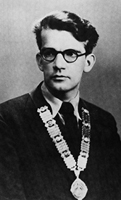The Heights of the Profession

Sharp's most notable contribution during his first period working as an academic was another book, Town Planning, a Pelican paperback published in 1940, frequently cited as the best-ever selling text on the subject. In 1941 he was seconded for two and half years to the Ministry of Works and Buildings, initially in a small team with William Holford and John Dower. His work during this time included acting as Secretary to the Scott Report on Land Utilisation in Rural Areas, undertaking work for a publication on villages, suppressed by the Ministry but later to emerge as Anatomy of the Village, and as Chairman of a technical group that produced an appendix to the Dudley Report on the Design of Dwellings entitled Site Planning and Layout in Relation to Housing. Once again finding working in a bureaucracy frustrating, Sharp returned to academia in 1943. On his return he devised a degree in town planning but his proposals became mired in University politics and in 1945 he once again tendered his resignation, this time to strike out as a planning consultant.
His first commission as a consultant had actually come via the City of Durham in 1943. This emerged in 1945 as Cathedral City and is the first of a series of 'reconstruction plans' on which much of Sharp's reputation subsequently rested, a number of which emerged as beautifully-produced books from the Architectural Press. The triumvirate of his most significant plans is formed by Durham, Oxford and Exeter. But these were frantically busy years. Reserving writing responsibilities to himself and working with only a small number of assistants, the years between 1944 and 1950 also saw commissions for plans for Todmorden, Salisbury, Chichester, St. Andrews, King's Lynn, Taunton, Stockport, Minehead and neighbourhood layouts for parts of Kensington and the new town of Hemel Hempstead. Few of these plans saw much if any practical implementation, as was common with plans produced at this time.
Other significant commissions in this period included the making of the first masterplan for the new town of Crawley – he had earlier worked upon a hypothetical new town, sponsored by the Bournville Trust, as a war time propaganda exercise. This opportunity for Sharp to realise his planning ideas in the form of a brand new settlement was again lost by resignation, following differences with the Chairman of the Development Corporation. A similar fate also met his commission by the Forestry Commission for a series of new forestry villages in remote Northumberland. Originally the intention was to design eight complete villages. Ultimately only three were partially built, robbed of the social facilities and completed form so important to Sharp. This was a particularly precious commission for Sharp, making the disappointment felt at the end result all the keener.

This account of the 1940s only scratches the surface of the intensity of Sharp's work at this time. He was also President of the Town Planning Institute 1945-1946 and busy successfully fighting various planning proposals through public inquiries, including a power station in Durham and a gas works in Oxford, both of which would have had a devastating impact on their respective cities. A very different sort of (and for once happy) commission was undertaken for St. John's College, Cambridge, re-planting the college grounds and in 1949-50 he was also President of the Landscape Institute. He was awarded a CBE in 1951.
Perhaps the principal cause for Sharp's subsequent drought of professional work was ironically the 1947 Town and Country Planning Act. This adoption of a greater role in planning by the state saw a decisive shift in the prosecution of such work away from consultants towards in-house work by local authorities. Sharp was unwilling or unable to follow other consultants in seeking work overseas (although he and Abercrombie were approached jointly about planning Chandigarh). It is perhaps typical of Sharp that his early career was spent mostly in local government in a profession then dominated by consultants, he exited academia at the time town planning was beginning to blossom as an academic subject (partly at his own promptings) and he became a consultant when the pendulum was swinging towards public sector work.




